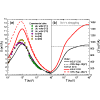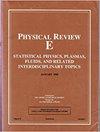模拟皮质骨中高能质子束的深度-剂量曲线和水当量比
IF 2.4
3区 物理与天体物理
Q1 Mathematics
引用次数: 0
摘要
我们通过结合分子动力学和蒙特卡洛技术的详细而精确的模拟,确定了临床能量质子束在皮质骨中的深度-剂量曲线、穿透范围和水当量比。模拟的基本输入量(停止功率和能量损失杂散)是从凝聚相靶的可靠电子激发光谱中获得的,其中考虑到了形成凝聚相靶的有机相和矿物相。我们使用这些输入数据进行的模拟与皮质骨靶的稀缺数据非常吻合,但与使用其他停止量进行的模拟有所不同,例如国际辐射单位和测量委员会在其广泛使用的第 49 号报告中提供的停止量[M. J. Berger et al.J. Berger 等人,质子和阿尔法粒子的停止功率和范围,国际辐射单位和测量委员会,马里兰州贝塞斯达,1993 年]。本文的研究结果强调了准确测定皮质骨的停止量对提高质子穿透范围和放射治疗所需的沉积剂量的毫米级精度的重要性。本文章由计算机程序翻译,如有差异,请以英文原文为准。

Simulation of depth-dose curves and water equivalent ratios of energetic proton beams in cortical bone
We have determined the depth-dose curve, penetration range, and water equivalent ratio for proton beams of clinical energies in cortical bone by means of a detailed and accurate simulation that combines molecular dynamics and Monte Carlo techniques. The fundamental input quantities (stopping power and energy loss straggling) for the simulation were obtained from a reliable electronic excitation spectrum of the condensed-phase target, which takes into account the organic and mineral phases that form it. Our simulations with these inputs, which are in excellent agreement with the scarce data available for a cortical bone target, deviate from simulations performed using other stopping quantities, such as those provided by the International Commission on Radiation Units and Measurements in its widely used Report No. 49 [M. J. Berger et al., Stopping powers and ranges for protons and alpha particles, International Commission on Radiation Units and Measurements, Bethesda, Maryland, 1993]. The results of this paper emphasize the importance of an accurate determination of the stopping quantities of cortical bone to advance towards the millimetric precision for the proton penetration ranges and deposited dose needed in radiotherapy.
求助全文
通过发布文献求助,成功后即可免费获取论文全文。
去求助
来源期刊

Physical review. E
物理-物理:流体与等离子体
CiteScore
4.60
自引率
16.70%
发文量
0
审稿时长
3.3 months
期刊介绍:
Physical Review E (PRE), broad and interdisciplinary in scope, focuses on collective phenomena of many-body systems, with statistical physics and nonlinear dynamics as the central themes of the journal. Physical Review E publishes recent developments in biological and soft matter physics including granular materials, colloids, complex fluids, liquid crystals, and polymers. The journal covers fluid dynamics and plasma physics and includes sections on computational and interdisciplinary physics, for example, complex networks.
 求助内容:
求助内容: 应助结果提醒方式:
应助结果提醒方式:


